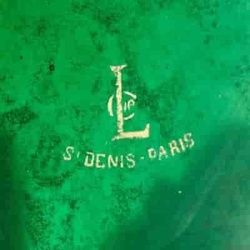
Производство Легра (Legras & Cie), организованное Огюстом-Жаном-Франсуа Легра в 1864 г. в результате приобретения уже действующего производства в Сен-Дени (сейчас пригород Парижа), на протяжении своей деятельности было очень успешным коммерческим предприятием, хотя художественный уровень его изделий и не был исключительно высок.
Сам Огюст Легра был большим поклонником Галле. С 1900 г. Легра начали производить стекло в стиле Art Nouveau. Из изделий этого времени наибольший интерес представляют вазы в стиле cameo и декорированные эмалью, внешне схожие с резным сердоликом.
Они изготавливались из нескольких слоев непрозрачного, бежево-розового стекла, на внешнем слое которого с помощью плавиковой кислоты вытравливался рисунок из цветов (хризантем, ирисов и т.д.), фруктов или водорослей. На последующих стадиях этот рисунок покрывался эмалью (зеленой - для листьев, и красной или коричневой (чаще всего) – для фруктов и цветов) и остекловывался в печи. В 1909 г. Огюст Легра отошел от дел, и производство перешло под руководство его сына Шарля. Компания продолжила производство изделий в стиле Art Nouveau.
Среди наиболее часто встречающихся изделий после 1909 г. можно назвать стекло, рисунки на котором выполнены травлением, часто на прозрачном фоне с «морозным узором». Также часто использовались эмали и позолота.







